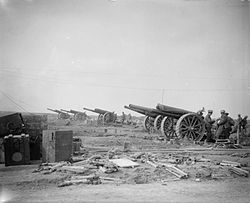Artillery battery
Historically the term "battery" referred to a cluster of cannon in action as a group, either in a temporary field position during a battle or at the siege of a fortress or a city.In the 20th century the term was generally used for the company level sub-unit of an artillery branch including field, air-defence, anti-tank and position (coastal and frontier defences).Improvements in mobile artillery, naval and ground; air attack; and precision guided weapons have limited fixed position's usefulness."[3] The standard NATO symbol for a company consists of a single vertical line placed above a framed unit icon.Advanced warships in the Age of Sail, such as the ship of the line, mounted dozens of similar cannons grouped in broadsides, sometimes spread over several decks.In time this trend reversed, with a proliferation of weapons of multiple calibers being arranged somewhat haphazardly about a vessel, many in mounts on the hull or superstructure with limited travel.This leap in heavy offensive armament from a standard four large caliber guns to a main battery of ten made all other battleships obsolete overnight, as the weight of broadside it could unleash, and overwhelming rate of fire a superior number of similar weapons could sustain, could overwhelm any similarly sized warship.Conventional artillery as a vessel's battery has been largely displaced by guided missiles for both offensive and defensive actions.Small caliber guns are retained for niche roles, such as the multi-barrel Phalanx CIWS rotary cannon used for point defense.In modern battery organization, the military unit typically has six to eight howitzers or six to nine rocket launchers and 100 to 200 personnel and is the equivalent of a company in terms of organisation level.In these armies the guns may be split into several fire units, which may deploy dispersed over an extended area or be concentrated into a single position.During the Cold War NATO batteries that were dedicated to a nuclear role generally operated as "sections" comprising a single gun or launcher.In these armies the guns may be split into several fire units, which may deploy dispersed over an extended area or be concentrated into a single position.







English cannonYoughalCounty CorkArmy units and organizationSubordinatedelementFireteamSectionPatrolPlatoonStaffelCompanySquadronBattalionCohortRegimentBrigadeDivisionLegionField armyCommandArmy groupTheaterDetachmentField forceTask forceBrigade groupFlying columnCombat commandRegimental combat teamBattalion tactical groupBattlegroupGroup armyCombat teammilitary organizationsartillerymortarrocket artillerymultiple rocket launcherssurface-to-surface missilesballistic missilescruise missilesbattlefield communicationcommand and controlwarshipsCrawfordsburnCounty DownNorthern Irelandhowitzerbattle of Austerlitz60-pounderNapoleonic WarsGrand Batteriesbattalionssquadronsregimentsbrigadescombined armsCoastal artilleryAmerican Civil WarUnion ArmyConfederate States ArmycaptaincolonelBermudaNATO Map SymbolsFrench battleship RedoutableAge of Sailship of the linebroadsidesgun turretsironcladUSS MonitorJohn EricssonbarbettesHMS Dreadnoughtmain batteryweight of broadside16"/50 caliber Mark 7gun turretIowa-classbattleshipsdual-purpose gunsanti-aircraftGerman battleship Bismarckguided missilesPhalanx CIWSpoint defense5"/54 caliber Mark 45 gunOtobreda 76 mm2nd Battalion 11th Marinesmilitary unithowitzersUnited States ArmymissileMultiple Launch Rocket Systeminfantryfire direction centerFrenchal-Qa'imField artillery team
